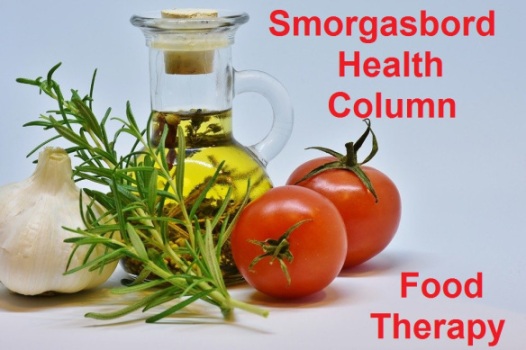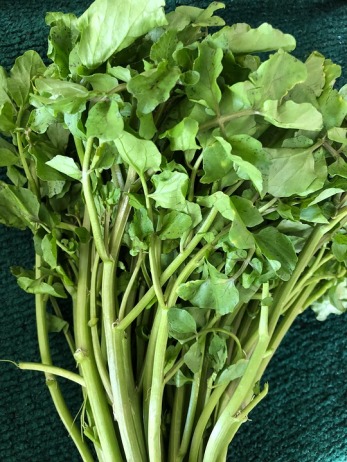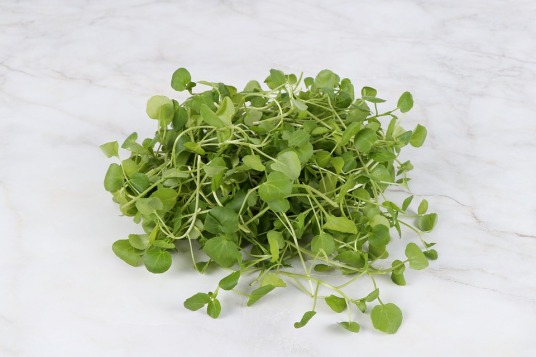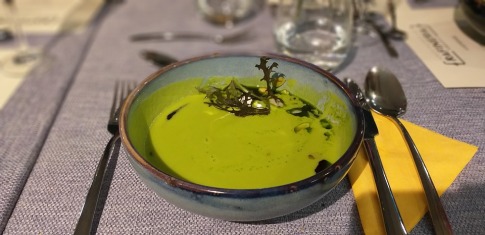
As a follow on from the recent series on the Weekly Grocery Shopping List of foods that contain the nutrients the body needs that contain the nutrients the body needs I am going to repeat my series from 2017 on the health benefits of some of our most common foods.
Food therapy is a broad term for the benefits to the body of a healthy, varied and nutritional diet of fresh foods.
Most of us walk through the fresh produce departments of our supermarkets without really paying much attention to the individual fruits and vegetables. This is a great pity because the vast majority of these foods have been cultivated for thousands of years, not only for their nutritional value but also for their medicinal properties. If you eat a healthy diet you are effectively practicing preventative medicine. A robust immune system, not only attacks external opportunistic pathogens, but also works to prevent rogue cells in the body from developing into serious disease.
NOTE – If you are on any prescribed medication do not take yourself off it without consultation with your doctor. If you follow a healthy eating programme and lose weight and are exercising you may not need the same dose and with your doctor’s agreement you may be able to reduce or come off the medication all together.
This week I share an edition to salads and also hot dishes that provides you with a great source of Iron.

First… what is so good about Watercress.
Its Latin name is Nasturtium officinale and it is part of the mustard family
Watercress history goes back over three thousand years to the Persians, Greeks and Romans. In the past it has been used as a breath freshener and palate cleanser as well as for its medicinal properties. Apparently Captain Cook included it in his sailors’ diet to combat scurvy and there are rumours that it is an aphrodisiac. But, before you all rush out to get your packet of watercress we better cover some of this lovely green vegetable’s other health benefits.
What is the nutritional content of Watercress?
Like all fresh fruit and vegetables Watercress has generous amounts of Vitamins A, C and E, which of course are fantastic antioxidants and it also contains calcium, folic acid and iron, all nutrients that I have covered before in the blog. Some interesting facts are that watercress contains more iron than spinach, more calcium than milk, has three times as much vitamin E as lettuce and has 150% more folic acid than broccoli.
Vitamin A: Retinol: Essential for healthy sight especially at night. It helps cells re-produce normally. It is needed for healthy skin, mucous membranes of the respiratory system, digestive and urinary tracts also bones and tissues. In reproduction it is required for the normal growth and development of the embryo and foetus. It has been shown to influence the function and development of sperm, ovaries and the placenta. As an Anti-oxidant it boosts the Immune System.
Vitamin C: Ascorbic Acid; An antioxidant that protects LDL cholesterol (low-density lipoprotein) from oxidative damage, leading to hardening of the arteries. May also protect against heart disease reducing the hardening of arteries and the tendency of platelets to clump together blocking them. Vitamin C is necessary to form collagen, which acts like glue strengthening parts of the body such as muscles and blood vessels. It aids with healing and is a natural anti-histamine.It is essential for the action of the Immune system and plays a part in the actions of the white blood cells and anti-bodies. It protects other antioxidants A and E from free radical damage and is involved in the production of some adrenal hormones.
Vitamin E: Tocopherol; As an antioxidant it protects cell membranes and other fat-soluble parts of the body such as LDL cholesterol from oxidative damage and blood vessels. It can be used topically for skin health and is involved in the reproductive system. It may help prevent circulatory problems that lead to heart disease and Alzheimer’s disease by preventing clots from forming. It improves the pulmonary function of the lungs and enhances the white blood cells ability to resist infection.This makes this little green leafed vegetable worth putting into your salads or cooking as an accompaniment to fish, meat and poultry.
Calcium: The most abundant and essential mineral in the body. There are approximately two to three pounds mainly found in the teeth and bones. Apart from its role in the formation of teeth and bones it is also required for blood clotting, transmission of signals in nerve cells and muscle contractions. There is some indication that higher calcium intake protects against cardiovascular disease particularly in women. If you are at risk of kidney stones consult your doctor before taking in additional calcium supplements. This also applies if you are suffering from prostate cancer where there may be a link between increased levels of dietary calcium in dairy products and this form of cancer. It is thought that excess calcium causes lower levels of Vitamin D, which helps protect against prostate cancer.
Folate: Folic Acid; Folic acid is a B Vitamin essential for cell replication and growth. It helps form the building blocks of DNA the body’s genetic information which is why it is recommended prior to conception and during the first 12 weeks of pregnancy to ensure the rapidly growing and replicating cells of the foetus are normal. This helps prevent low birth weight and abnormalities such as Heart defects or lip and palate malformations.It is essential for transporting co-enzymes needed for amino acid metabolism in the body and is necessary for a functioning nervous system.
Iron: The main function of iron is in haemoglobin, which is the oxygen-carrying component of blood. When someone is iron deficient they suffer extreme fatigue because they are being starved of oxygen. Iron is also part of myoglobin which helps muscle cells store oxygen and it is also essential for the formation of ATP.
Dietary iron is found in two forms, haem iron and non-haem iron. (Heme in US).
- Haem iron, which is the most absorbable, is found only in animal flesh as it is taken from the haemoglobin and myoglobin in animal tissue.
- Non-haem iron is found in plant foods such as watercress.
Other duties that are performed by iron include the production of energy as a component of a number of enzymes and it is also involved in the production of the nonessential amino acid, L-Carnitine, important for the efficient metabolism of fat.
What are the health benefits of Watercress?
Well apart from obviously providing a great nutritional fix every time you eat it, there are certain illnesses that watercress has been applied to during the centuries. Some of the more common ones are cataracts, coronary heart disease, lung and breast cancers and hormone related cancers.
Eating it regularly along with the other dark green leafy vegetables in a healthy eating programme may help reduce your LDL cholesterol levels, alleviate PMS or menopausal problems, lower blood pressure and also boost your immune system.
Some other older cultures have used watercress extensively since there was no pharmacy around the corner and they make interesting reading.

- The Romans treated insanity with vinegar and watercress (you may have stayed mad but your lips were so puckered you stopped raving) Apparently Roman emperors ate watercress to help them make ‘bold decisions’.
- Eating a bag of watercress is meant to cure a hangover.
- Brazilian researchers found that the extract of watercress appeared to possess anti-tumour properties and it was active against TB.
- Irish monks were said to survive on watercress sandwiches, which may have been because on holy islands there was no supermarket let alone a pharmacy!
- In the 17th century it was used to cleanse the blood (much more pleasant that bloodletting)
- In general watercress has traditionally been considered as a diuretic, expectorant, purgative and stimulant and considered ideal for anaemia, eczema, migraines, toothache, kidney and liver complaints, TB, skin conditions such as warts and of course tumours.
- Popeye loved his Spinach but watercress with its extra iron would have been better, although it does not perhaps sound quite to manly to shout ‘Olive Oyl, where’s me watercress, Bluto’s on me doorstep!”
Watercress makes a wonderful summer soup and is very quick to make, and you can add to omelettes and other egg dishes, as well as salads.

Here’s my recipe for watercress soup
Ingredients
- Vegetable Stock about 2 pints
- 2 large potatoes, peeled and cubed
- 1 large bunch of watercress washed and roughly chopped.
- 1 large onion chopped
- 2 cloves of garlic chopped.
- 8oz of natural yoghurt
- Salt and pepper to taste.
To Prepare
- Combine your potatoes and stock in a large saucepan and bring to the boil. Cover and reduce the heat and simmer for about 12 minutes until the potato is tender.
- Add the watercress, onions and garlic and bring back to the boil. Cover and remove from the heat and let it stand for about 5 minutes.
- Puree the soup in a blender, stir in the yoghurt and seasoning to taste.
- Chill in the fridge before serving.
Carol Taylor has some wonderful recipes that will help you include in your diet on a regular basis: Cook from Scratch with Watercress by Carol Taylor
©Sally Cronin Just Food for Health 1998 – 2020

I am a qualified nutritional therapist with twenty-two years experience working with clients in Ireland and the UK as well as being a health consultant on radio in Spain. Although I write a lot of fiction, I actually wrote my first two books on health, the first one, Size Matters, a weight loss programme 20 years ago, based on my own weight loss of 154lbs. My first clinic was in Ireland, the Cronin Diet Advisory Centre and my second book, Just Food for Health was written as my client’s workbook. Since then I have written a men’s health manual, and anti-aging programme, articles for magazines and posts here on Smorgasbord.
If you would like to browse my health books and fiction you can find them here: My books and reviews 2020
Thank you for dropping in today and your feedback and questions are very welcome.. thanks Sally.

Pingback: Smorgasbord Health Column – Food Therapy – Watercress – More Iron than Spinach — Smorgasbord Blog Magazine – TalkingPoint
This is the kind of information that the world needs at this time.
LikeLiked by 1 person
Thank you glad you found interesting.
LikeLiked by 1 person
Welcome.
LikeLike
LikeLike
Thanks.. and have a good Wednesday
LikeLiked by 1 person
new york free health care Health is a thousand blessings, if a person is in good health, his life will be very good. Here is a new york free health care for health tips.
LikeLiked by 1 person
Pingback: Smorgasbord Blog Magazine – Weekly Round Up – June 28th – July 4th 2020 – Music Festival, Book Covers, Fairy Stories, Poetry, Book Reviews and Author Promotions | Smorgasbord Blog Magazine
Thanks for the recipe Sal, looks yum. I don’t typically do much with watercress, and I am astounded about the healthful nutrients in what often looked like a plate decorator to me, lol. I know the Queen eats them in sandwiches lol ❤
LikeLiked by 2 people
Thanks Debby and she is 93.. and if Prince Philip is eating them too.. he is 99.. It must be the watercress lol..♥
LikeLiked by 1 person
Okay, I’ll bite. But don’t start forcing cucumbers on me – they repeat LOL 🙂 xxx
LikeLiked by 1 person
I only use as eye therapy…♥
LikeLiked by 1 person
Me too! LOL go figure! ❤
LikeLiked by 1 person
♥
LikeLiked by 1 person
Do you peel your cucumbers dgkaye? I once read you shouldn’t as the skin contains something that helps stop the repeating. I don’t know if that’s true. Maybe Sally can tell us.
LikeLiked by 2 people
Not sure Viv.. I tend to keep the skin on most things except for cucumber… I will check it out…hugsx
LikeLiked by 1 person
Honestly Viv, I haven’t eaten them in decades, but probably I didn’t peel them. I’m good without them lol 🙂
LikeLiked by 1 person
I must try your recipe Sally. I’ve been feeling somewhat bloated of late. Lockdown belly!
LikeLiked by 1 person
Hope you enjoy Marje … I found that I was making bread and eating a little too much of it..warm with butter.. now freezing and only eating sparingly..xx
LikeLiked by 1 person
I love my food and cakes, treats etc! So must cut down. All my clothes are tight.
LikeLiked by 1 person
It is a crime that it takes five minutes to put it on and 3 months to take it off…lol… xx
LikeLike
Yes, that what I’m thinking Sally! xx
LikeLiked by 1 person
I don’t think watercress tastes as spicy as it used to. The watercress I’ve had recently has tasted a bit bland rather than peppery.
I love the watercress soup recipe. I’m going to get more of the stuff in future.
LikeLiked by 2 people
There are different varieties and some may well be cultivated to be less peppery for average taste. I buy organic here which seems to be quite peppery…xx
LikeLiked by 1 person
I’ve had bad experiences with spinach – my mother used to cook the stuff to a slime, put a wet puddle of it on a plate and top it with a poached egg. I’m afraid watercress raised the same fears. However, now I’ve read the article and seen it’s benefits I’m more than happy to try the soup – which bears no relationship to my mother’s cooking.
LikeLiked by 2 people
I like watercress for that reason.. it tastes great uncooked or added to savoury dishes a couple of minutes before finishing…nothing worse than soggy greens..hugsx
LikeLike
Fabulous information, Sally – so many health benefits. That soup looks wonderful, so I must try it. It might even cure my insanity. Toni x
LikeLiked by 3 people
Lol.. I am not sure it will go that far Toni.. has not done much for mine! hugsx
LikeLiked by 1 person
❤️😂
LikeLiked by 1 person
Ooh, thanks for this info, Sally. What about cress? Is that just as good?
LikeLiked by 1 person
It is Stevie.. it comes from the same family and has plenty of antioxidants other nutrients and whilst not as peppery is just as tasty in egg sandwiches… hugs
LikeLiked by 1 person
Well well well, one more delicious soup for the summer, not to mention all the health benefits. Can’t thank you enough. Will certainly add this to the menu. I will miss your posts while away but looking forward to them upon my return. All the best. Hugs
Reblogged on « Improvisation » The Art of Living
https://williampriceking.tumblr.com/
LikeLiked by 1 person
Thanks William and enjoy the soup.. have a wonderful summer and look forward to starting your new series in September …hugsx
LikeLike
Great information here, Sally. I didn’t know watercress had so much iron. That is good to know. I don’t think I’ve ever eaten it but Enid Blyton always wrote about watercress sandwiches.
LikeLiked by 2 people
Thanks Robbie. Glad you found interesting.. If you can get hold of it in season it is a great addition to hot and cold dishes. and sandwiches of course…hugs
LikeLiked by 1 person
Pingback: Smorgasbord Health Column – Food Therapy – Watercress – More Iron than Spinach | Retired? No one told me!
I have been fancying an egg and cress sandwich for the last week so a timely reminder to buy watercress when shopping next… I also should make that pork again as it is very nice…Thank you for sharing my watercress recipes again,with a reminder as to the health benefits, Sally… Hugs 🙂 Pressed this xxx
LikeLiked by 2 people
Thanks Carol.. and we are lucky to have some great organic farm produce here and watercress definitely on the menu this time of year.. thanks for sharing the post..♥
LikeLiked by 1 person
Always a pleasure, Sally…Thats good to hear that you have access to some great produce where you live…Hugs xx
LikeLiked by 1 person
I love the slightly peppery flavour of watercress in salads but had no idea it was so good for you as well. Bit cold for salads now but might give that soup a try. I looks delicious.
LikeLiked by 2 people
Great thanks Meeks.. and also very nice in an omelette or frittata.. x
LikeLiked by 1 person
Mmm….I LOVE frittata. Thanks for reminding me. 😀
LikeLiked by 1 person
Happy to oblige Meeks.xx
LikeLiked by 1 person
Sally, I am all for a “robust immune system.” I do not know whether I have eaten watercress. It is now on on this week’s grocery list. The recipe looks great. I may try watercress in my morning shake.
LikeLiked by 2 people
Thanks Erica.. it is actually very versatile and crisper and less watery than spinach when cooked in dishes such as eggs..x
LikeLiked by 1 person
Thank you for the very interesting recipe. As it looks like yours,after i had prepared it myself, i will eat. Lol Somedays i think i should make a course as a food designer too. 😉 Michael
LikeLiked by 3 people
I am sure it will look very tempting when you make it Michael.. and it is less important how it looks, as it does how good it tastes..hugs
LikeLiked by 1 person
🙂 Lets look forward. I am not best in decorating, only in eating. 😉
LikeLiked by 1 person
xx
LikeLiked by 1 person
😉
LikeLike